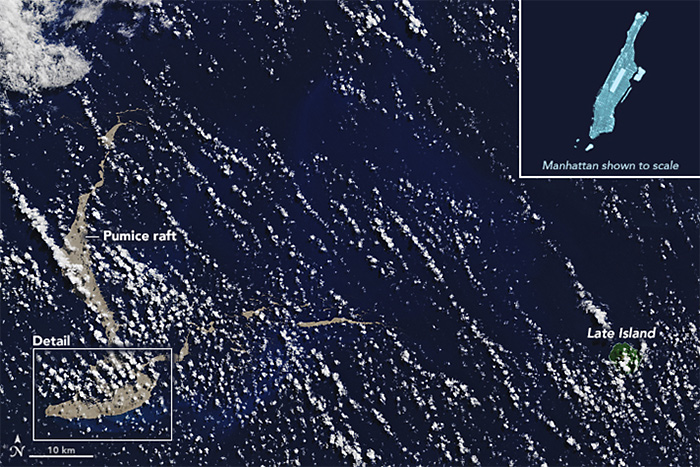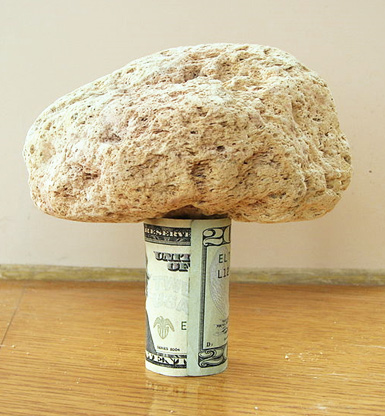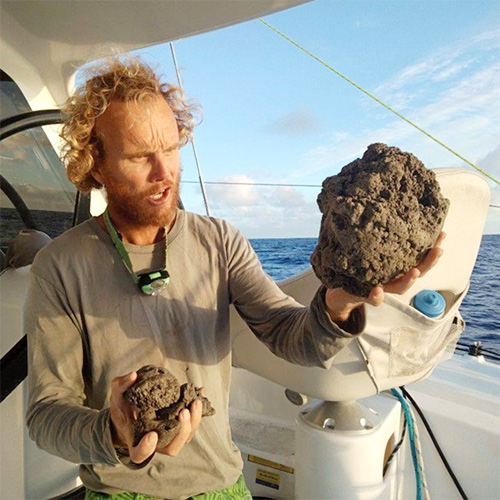
Credit: NASA
Recently, a group of sailors in the South Pacific encountered something extraordinary. One minute they were sailing in water. The next, in a sea of rocks.
Floating rocks, some the size of basketballs, as far as the eye could see. Imagine their amazement!
Turns out the rocks were pumice, which was extruded by an undersea volcano near the island of Tonga.
Pumice is molten rock filled with gas bubbles, ejected at high pressure like whipped cream from a can. When it hits the seawater, it hardens instantly, trapping the gas within it, making a rock that’s lighter than water.
The pumice then floats to the surface where it forms huge rafts of rocks, from pebble size to much larger.
They’ll float until wave action breaks up the rocks as they grind against each other, or they get waterlogged and sink.
These rock “rafts” form only about twice per decade but can be enormous.
In 2012, one formed off the coast of New Zealand that was 300 miles long.
The raft from Tonga was the size of Manhattan and was floating toward the Great Barrier Reef.
The surface of pumice is rough, full of craters and crevices, making it perfect for mollusks, corals and other sea creatures to attach themselves for the ride.
Scientists think that pumice rafts like these have helped life-forms cross open oceans and start new colonies in new places. Much the way humans did on rafts of our own making.
Background
Synopsis: In August 2019, several groups of sailors were surprised to find themselves sailing through rocks as far as the eye could see. It was pumice that had been extruded from a subsea volcanic vent near Tonga and had accumulated into a raft the size of Manhattan. The raft is headed toward the Great Barrier Reef carrying organisms that may bring new life to the reef. Some scientists suggest that rafts such as this one were instrumental in the distribution of life-forms around the planet.

- Pumice is a light-colored volcanic rock that floats.
- Pumice forms when molten igneous rock is ejected at high pressure from a volcano, similar to the whipped cream that comes from a pressurized can.
- When the explosion releases the pressure, the foamy mass cools suddenly, freezing the air bubbles in place, creating a lightweight, low-density rock filled with air bubbles.
- Pumice is usually rhyolitic in composition, rich in silica and aluminum.
- Like frothed milk on cappuccino, frothed rocks float on water because of their entrained air bubbles.
- When volcanoes extrude their foamy eruptions under water, the magma solidifies into pumice, which breaks up into chunks that float to the sea surface.
- As the pumice collects, it forms accumulations called pumice rafts. Sailors in the South Pacific have reported pumice rafts for centuries.
- In 2012, a raft up to 154 mi2 (400 km2) near New Zealand could be seen by satellites and was reported by sailors. It was caused by the underwater eruption of Havre submarine seamount in the Kermadec Islands.
- Many of the pumice raft sightings have been attributed to volcanoes along the Tonga Trench, north of New Zealand.
- Rafts include marble- to basketball-sized chunks, although some larger pieces have been reported that stick up 2 ft (60 cm) above the water’s surface.
- In 2019, a raft larger than Manhattan Island (23 mi2 or 59 km2) surprised sailors and was mapped using remote sensing.
- This raft is part of a whole group of rafts that is estimated to have an area of at least 58 mi2 (150 km2). These rafts form and re-form as they are moved by waves and currents.
- An underwater vent northwest of Vava’u Island appears to have sourced the 2019 raft. Scientists estimate the volcano’s top is about 130 ft (40 m) below the sea surface.
- Volcanoes in the area, such as the Fonualei Volcano, have been erupting frothy pumice during explosive volcanic eruptions sporadically since at least 1846 when large rafts were reported by sailing vessels.
- In the 2019 event, sailors were amazed by the sea of rocks at least 6 in (15 cm) thick surrounding and clunking into the hulls of their boats for as long as eight hours of sailing.
- Pumice rafts aren’t very common; on average, about two are reported each decade.
- Rafts may last for months or years until the pumice degrades into dust or finally gets waterlogged and sinks.
- The powder that forms from the abrasion of the pumice chunks may nourish phytoplankton blooms.
- The rugged surface of pumice makes the fragments perfect places for marine life to hitch a ride across ocean basins.

Sailor Michael Hoult with chunks of pumice from the 2019 eruption encountered while sailing near Vava'u Island in Tonga. Credit: Michael and Larissa Hoult (Sail Surf ROAM/Facebook) - Mollusks, barnacles, algae and corals have all been found growing on pumice.
- Pumice rafts can travel great distances on currents, but most float westward toward Australia.
- In 2001, a huge raft made its way as far as Queensland.
- In 2012, scientists showed that pumice rafts increase the dispersal of marine organisms: More than 80 species had traveled thousands of kilometers westward from the 2006 eruption of Home Reef Volcano in Tonga.
- The 2019 raft looks like it is headed toward the eastern Coral Sea, after passing by Fiji, Vanuatu and New Caledonia.
- Based on the trajectory and speed of currents and previous pumice rafts, researchers are optimistic that the raft will make its way toward the Great Barrier Reef during the coral spawning season, bringing reef dwellers and healthy new corals with it.

